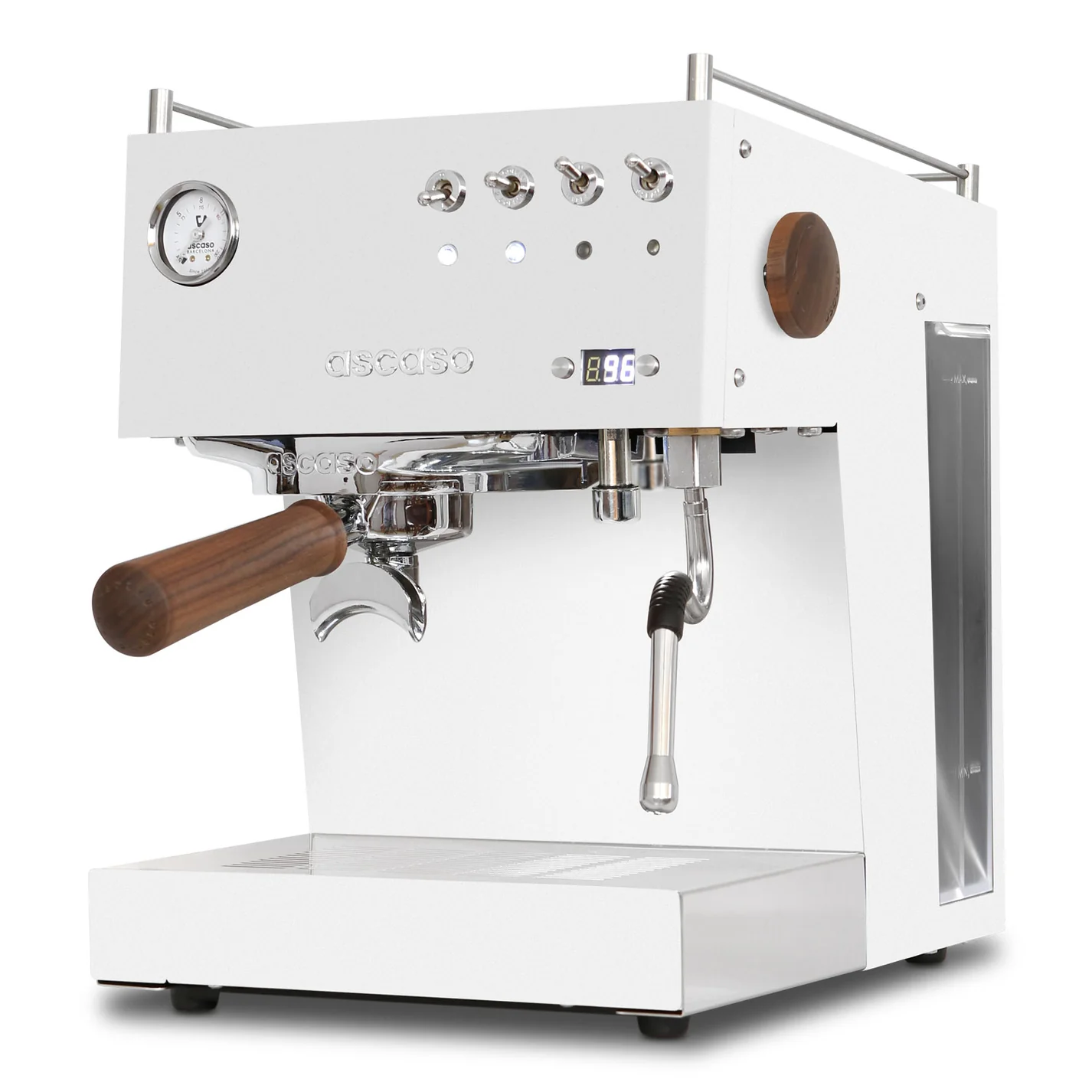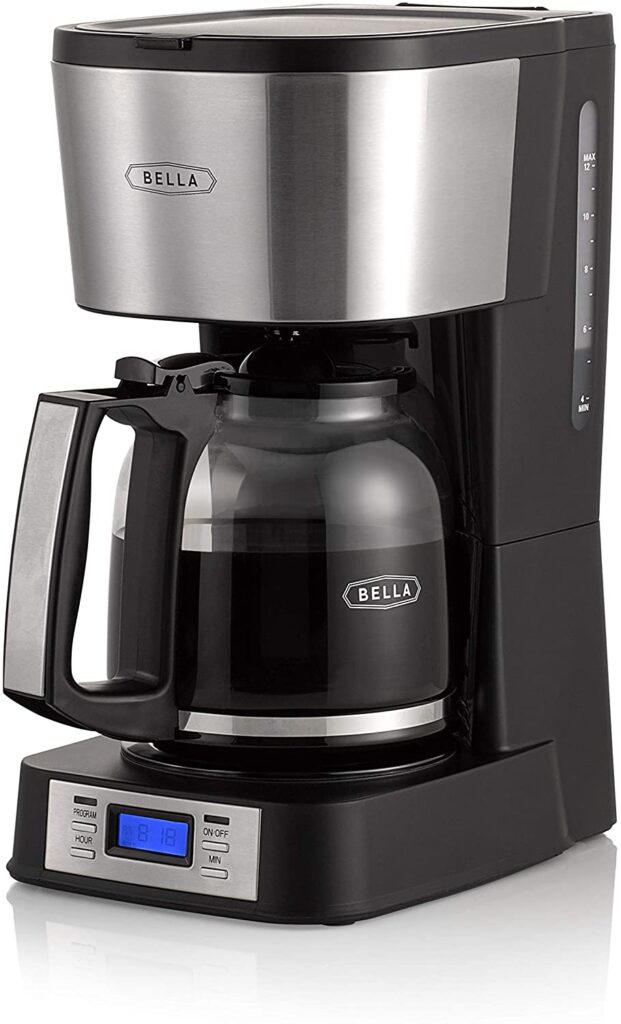How Much Caffeine is in a Shot of Espresso? +5 Proven Facts

Heads up: This content is reader-supported, meaning we may earn a small commission if you click on some of our links.
Have you ever wondered how much caffeine is in a shot of espresso? We all know espresso is a concentrated (and delicious) coffee that packs a punch. But exactly how much caffeine is in a shot of espresso?
A standard espresso shot contains around 64mg of caffeine. This amount can vary depending on several factors, such as the type of coffee bean used, the brewing method, and the size of the shot. But on average, you can expect an espresso shot to provide you with a quick burst of energy.
It’s important to note that while espresso shots are small, they can still contain significant caffeine. So, if you’re sensitive to caffeine or looking to limit your intake, you may consider choosing a decaf coffee, ordering a smaller size, or diluting your espresso with milk. Flat white, anyone?
Table of Contents
What is Caffeine?
Before we discuss how much caffeine is in a shot of espresso, let’s quickly review what caffeine is. Caffeine is a natural stimulant in various plants, including coffee beans, tea leaves, and cocoa beans. It’s the most commonly used psychoactive substance worldwide, consumed by millions daily.
When we consume caffeine, it blocks the action of adenosine in our brain, which is a neurotransmitter that promotes sleep and suppresses arousal. As a result, caffeine enhances our mental alertness, concentration, and physical performance.

The effects of caffeine intake can vary depending on an individual’s sensitivity, the amount consumed, and the source of caffeine. In general, caffeine has a half-life of about 5 hours, meaning half of the caffeine consumed will be eliminated from the body after 5 hours.
Consuming too much caffeine can lead to adverse effects, such as insomnia, anxiety, restlessness, and increased heart rate. Therefore, it’s essential to be aware of how much caffeine is in an espresso shot, coffee, tea, or other beverages and consume it in moderation.
But before we discuss how much caffeine is in a shot of espresso, let’s examine espresso in more detail.

Understanding Espresso
Espresso is a concentrated coffee drink that forces hot water through finely-ground coffee beans. It is typically served in small shots and is known for its intense flavor and high caffeine content. This section will examine what makes espresso unique and how much caffeine can be found in a shot.
When making espresso, a few key factors can affect the final product. These include the type of coffee beans used, roast level, the grind’s fineness, and the pressure and temperature of the water used to extract the coffee. Because of these variables, how much caffeine is in a shot of espresso will vary depending on how it is prepared.

Despite its reputation as a high-caffeine drink, a shot of espresso contains less caffeine than a typical cup of brewed coffee. This is because espresso is served in smaller portions and is more concentrated than regular coffee. However, because it is consumed quickly in a concentrated form, many people find that espresso provides a more immediate and intense caffeine boost than other coffee drinks.
Espresso is a unique and flavorful coffee drink with a concentrated caffeine boost in a small package. Whether you prefer a single shot or a double, understanding the factors that affect the caffeine content of your espresso can help you make the most of this beloved beverage.
Next we’ll examine how much caffeine is in a shot of espresso and compare it to other sources of caffeine.

How Much Caffeine is in a Shot of Espresso?
Espresso is often considered to be the most potent coffee drink when it comes to caffeine content. But just how much caffeine is in a shot of espresso? Let’s take a look.
According to Taste of Home, a single serving of espresso (about one ounce) has about 64 milligrams of caffeine. However, the caffeine content can vary depending on the type of coffee beans used, the brewing method, and the size of the shot.
For example, according to Consumer Reports, a Starbucks espresso shot (0.75 ounces) has 75 mg of caffeine. The roast level of the beans may also impact caffeine content, with darker roasts generally having less caffeine than lighter roasts.
It’s worth noting that espresso is often consumed in much smaller quantities than other coffee drinks, like drip coffee or cold brew. As Coffee Affection notes, a serving of espresso is around 1.5 ounces, which contains about 77 mg of caffeine. By comparison, an 8-ounce cup of regular coffee has about 96 mg of caffeine.
On average, a single shot of espresso contains around 64 milligrams of caffeine, while a double shot, or doppio, contains about 128 milligrams. However, it is essential to note that the caffeine content of espresso can range from as little as 30 milligrams to as much as 100 milligrams per shot, depending on the factors mentioned above.
Remember that how you consume your espresso can affect how quickly you feel the effects of the caffeine. Drinking espresso quickly can result in a more immediate jolt of energy while sipping it slowly in the form of a latte or cappuccino can provide a more gradual boost. While espresso may not have the highest caffeine content per serving, it can still provide a potent energy boost when consumed in moderation.

5 Factors Influencing Caffeine Content in Espresso
Several factors can influence how much caffeine is in a shot of espresso. Here are some of the most important factors to consider:
1. Coffee Bean Type
The type of coffee bean used to make espresso can have a significant impact on the caffeine content. Generally, Arabica beans have lower caffeine content than Robusta beans. This means that espresso made with Arabica beans will typically have less caffeine than espresso made with Robusta beans.
2. Roast Level
The roast level of the coffee beans can also affect the caffeine content in espresso. A darker roast has less caffeine than lighter roasts. This is because the longer roasting process breaks down the caffeine molecules. So, if you prefer a more potent espresso with more caffeine, you may opt for a lighter roast.
3. Grind Size
The size of the coffee grounds used to make espresso impacts the extraction and can also affect the caffeine content. Finer grounds tend to produce espresso with higher caffeine content than coarser grounds. This is because more caffeine is extracted from the smaller particles during brewing, as more of the bean is exposed to the brewing water.

4. Brewing Method
The brewing method used to make espresso can also impact the caffeine content. For example, espresso made with a stovetop espresso maker may have lower caffeine content than espresso made with an espresso machine. This is because the brewing time and pressure differ, affecting how much caffeine is extracted from the beans during brewing.
5. Serving Size
Finally, the serving size of the espresso shot can also affect how much caffeine is in a shot of espresso. A standard shot of espresso is typically around 1 ounce and contains about 64 milligrams of caffeine. However, some coffee shops may serve double or triple espresso shots with more caffeine. Look for other espresso shots on coffee shop menus, like ristretto or lungo. These shots are made with more or less water, resulting in varying caffeine levels.

Caffeine Comparison: Espresso vs. Other Beverages
When we look at how much caffeine is in a shot of espresso, it might be considered the king of coffee. But how does espresso compare to other popular beverages? Let’s take a look.
Espresso vs. Drip Coffee
Drip coffee is the most common way of brewing coffee in the US and is often the go-to for many coffee drinkers. However, when it comes to caffeine content, a shot of espresso contains less caffeine than a cup of drip coffee.
According to the Department of Agriculture nutrition data, an espresso typically has 64 mg of caffeine in 1 ounce, while a cup of drip coffee has 12 to 16 mg of caffeine per ounce. Therefore, an 8-ounce cup of drip coffee contains about 96 – 128 mg of caffeine.
Espresso vs. Cold Brew
Cold brew has become increasingly popular due to its smooth and less bitter taste. But how does it compare to espresso in terms of caffeine content? Cold brew contains less caffeine than espresso on a per-ounce basis.
However, according to Healthline, a typical 12-ounce cold brew contains about 150 mg of caffeine. In comparison, a shot of espresso contains around 64 mg of caffeine. Therefore, cold brew contains more caffeine than espresso per serving.

Espresso vs. Energy Drinks
Energy drinks are known for their high caffeine content and are often consumed for a quick energy boost. However, compared to an espresso shot, an energy drink contains significantly more caffeine. For example, a 16-ounce can of Monster Energy contains 160 mg of caffeine, not to mention over 50 grams of sugar (yikes).
Espresso vs. Tea
Tea is another popular beverage that contains caffeine. However, the caffeine content in tea varies depending on the type of tea and the brewing method. On average, a cup of black tea contains around 47 mg of caffeine, while a cup of green tea contains about 28 mg. This means that a shot of espresso contains more caffeine than a cup of green or black tea.

Caffeine Consumption Guidelines
When it comes to caffeine consumption, it’s essential to keep in mind that everyone’s caffeine tolerance level is different. However, some general guidelines can help you determine how much caffeine is safe to consume.
According to the Mayo Clinic, up to 400 milligrams of caffeine daily is safe for most healthy adults. That’s roughly the amount of caffeine in four cups of brewed coffee, ten cans of soda, or two energy drinks. However, remember that the caffeine content in beverages varies widely, especially among energy drinks. So, it’s essential to check the label or do some research to determine the amount of caffeine in your favorite beverage.
If you’re sensitive to caffeine or experience adverse side effects like headaches, restlessness, or anxiety, you may want to reevaluate your caffeine intake and consider decaf espresso.

It’s also important to note that caffeine can have a cumulative effect. That means consuming multiple caffeinated beverages throughout the day can add up, potentially leading to adverse side effects. Staying hydrated and maintaining a balanced diet is essential if you like to spread your consumption throughout the day.
Listening to your body and determining what amount of caffeine works best for you is essential. By being mindful of caffeine consumption and following these guidelines, you can enjoy that afternoon iced coffee without overdoing it.
Frequently Asked Questions
How much caffeine is in a latte?
A latte typically contains one or two espresso shots, depending on the size, which means it can have between 64 and 128 milligrams of caffeine. However, the amount of caffeine in a latte can vary widely depending on the coffee bean type, the roast level, and the brewing method.

Caffeine in drip coffee
Drip coffee usually has more caffeine than a shot of espresso. An 8-ounce cup of drip coffee can contain between 95 and 200 milligrams of caffeine, while a 1-ounce espresso typically has 64 milligrams of caffeine.
Is two shots of espresso a lot of caffeine?
Two shots of espresso, or double espresso, can contain between 128 and 252 milligrams of caffeine, which is a moderate amount for most adults. However, caffeine sensitivity can vary widely from person to person, so it’s essential to pay attention to your body’s reaction and limit your caffeine intake accordingly.
How much caffeine should you have in a day?
According to the Mayo Clinic and FDA, up to 400 milligrams of caffeine daily is safe for most healthy adults. However, some people may be more sensitive to caffeine than others, and excessive caffeine consumption can cause adverse side effects such as anxiety, insomnia, and heart palpitations.

How much caffeine is in a shot of espresso vs. coffee?
A 1-ounce espresso typically has 64 milligrams of caffeine, while an 8-ounce cup of drip coffee can contain between 95 and 200 milligrams. On a per-ounce basis, espresso has much more caffeine than drip coffee. However, drip coffee is typically served in 8-16 ounce servings, and the actual caffeine levels can vary widely depending on the brewing method, the type of coffee beans used, and the roast level.
Is 200 mg of caffeine a lot?
For most adults, 200 milligrams of caffeine is considered a moderate amount. However, caffeine sensitivity can vary widely from person to person, and some people may experience adverse side effects such as anxiety, insomnia, and heart palpitations with even small amounts of caffeine. It’s essential to pay attention to your body’s reaction and limit your caffeine intake accordingly.
ABOUT THE AUTHOR
Heather Calatrello
Heather is the head coffee roaster and founder of ShedLight Coffee Roasters in San Diego, CA. Her solar-powered coffee roastery was recently the subject of a BlueDot Living dispatch, and she has repeatedly been featured in Food & Wine, Real Simple, Parade, and more.

